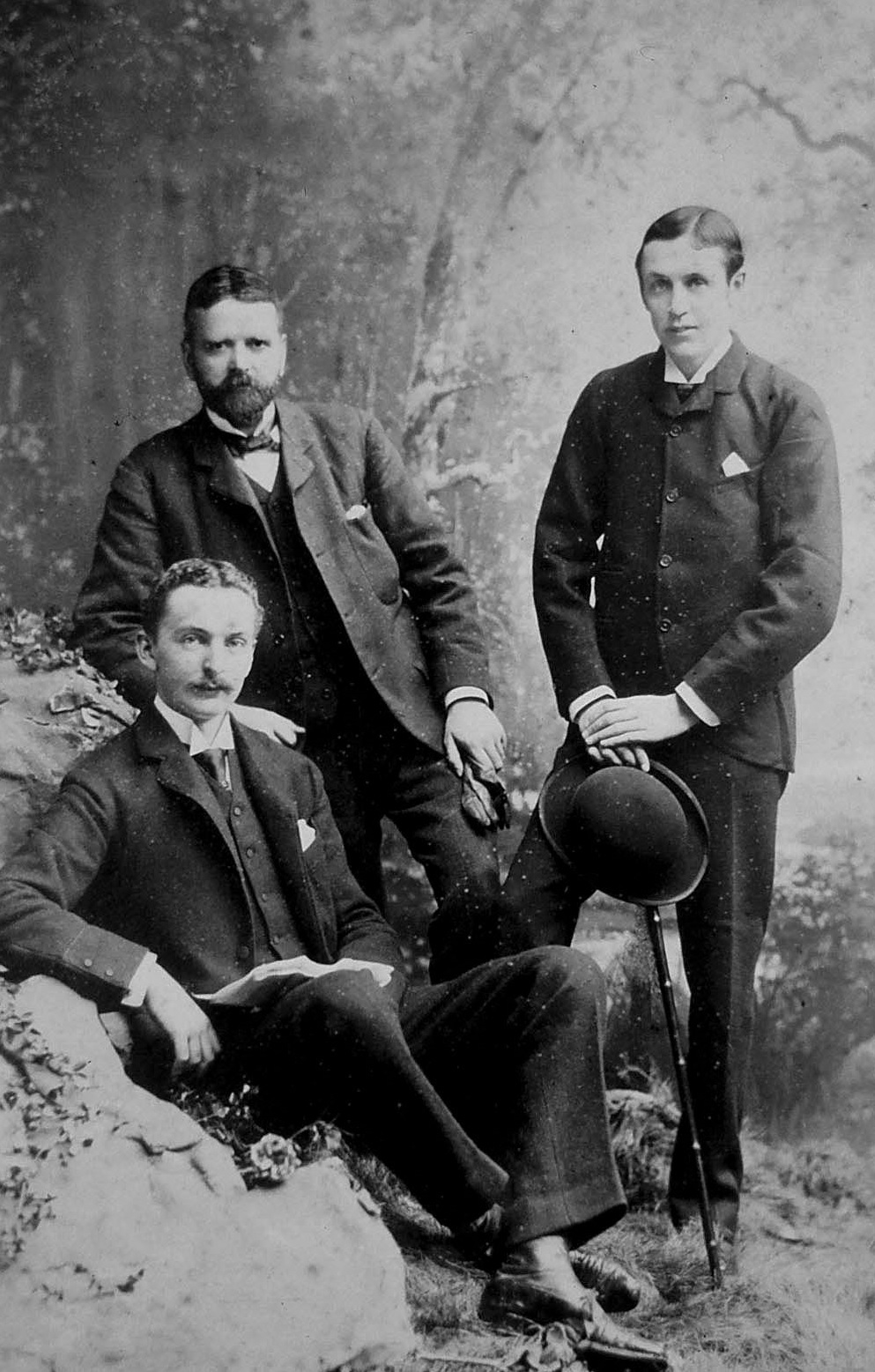
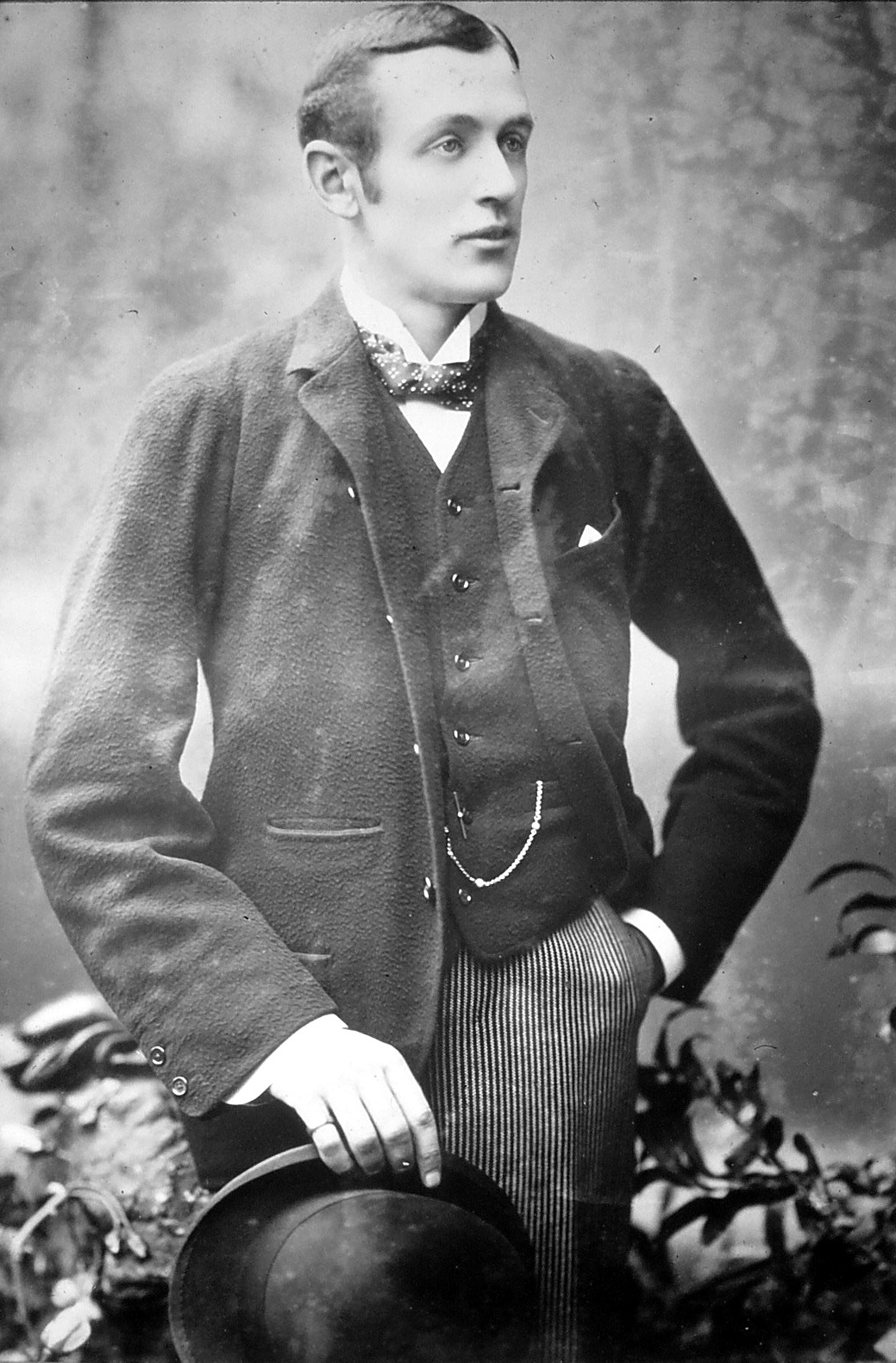
Many Newmarket stables deserve to be called historic, whether it is Heath House because of its links with Tregonwell Frampton, Park Lodge for its possible links with the very first Royal Palace and Stables, or Palace House for its confirmed links with Charles II, but Pegasus Stables, formerly Falmouth House and Lodge, is right up there with them for its close links with the great Fred Archer. The script is a sad, tragic, compelling story of the greatest of all Victorian jockeys and his desire to build a family home for his new wife and young family. In 1882, when aged just 25, Fred Archer proposed to Rose Nellie Dawson, eldest daughter of John Dawson and she accepted. He wanted to build a suitable family house, spending £20,000 (equivalent to £2.4 million in 2019) building Falmouth House, with Falmouth Lodge next door.
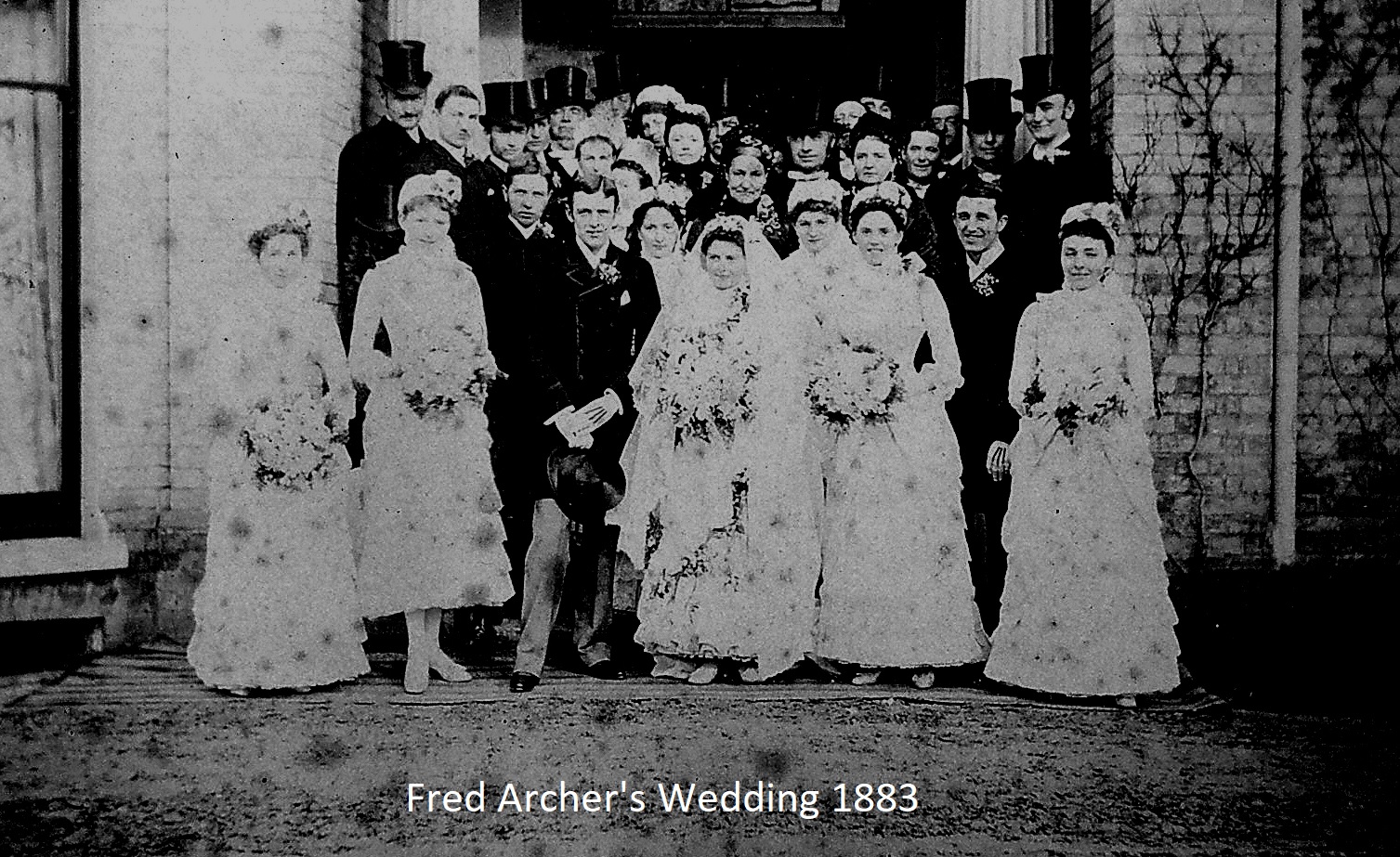
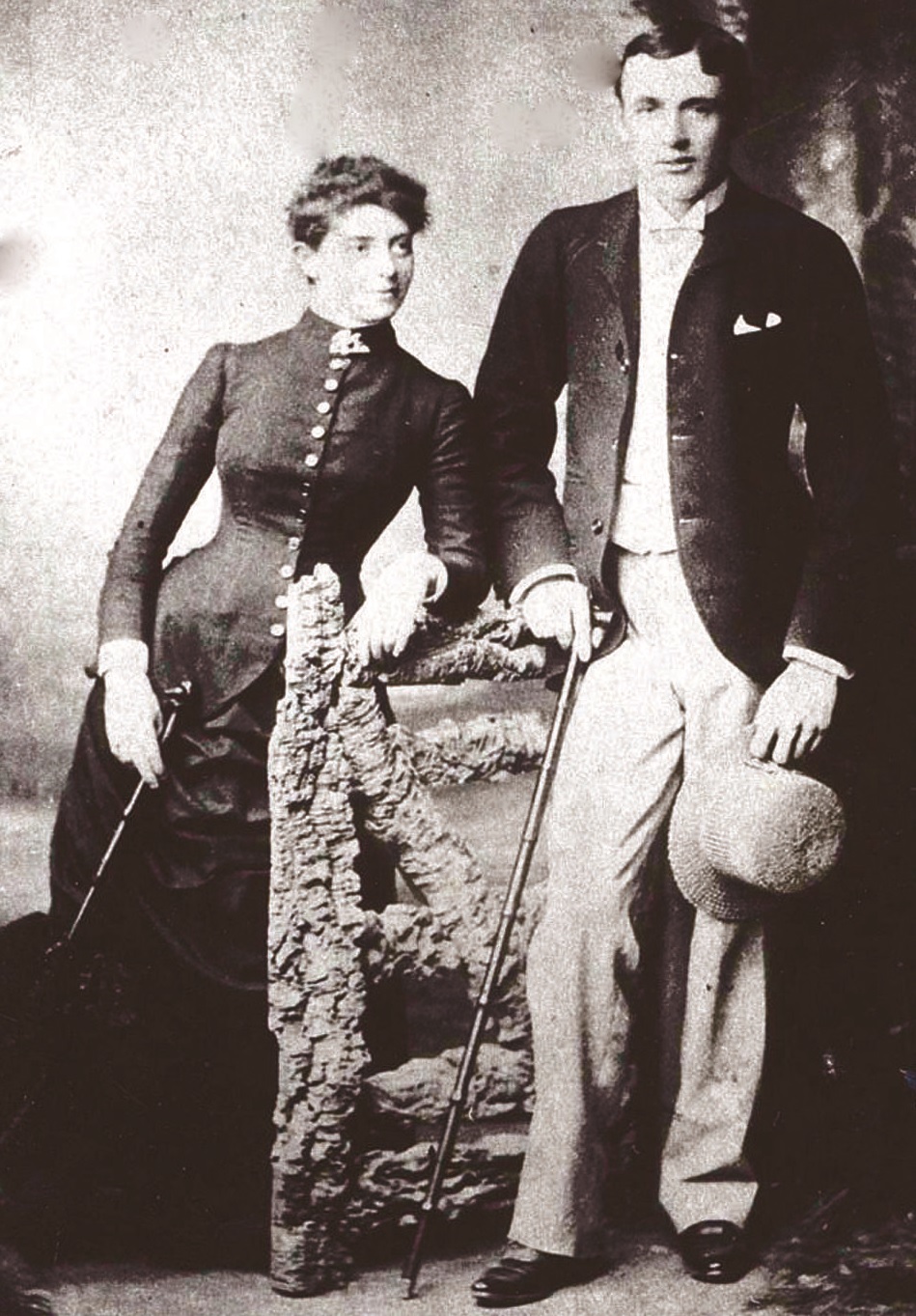
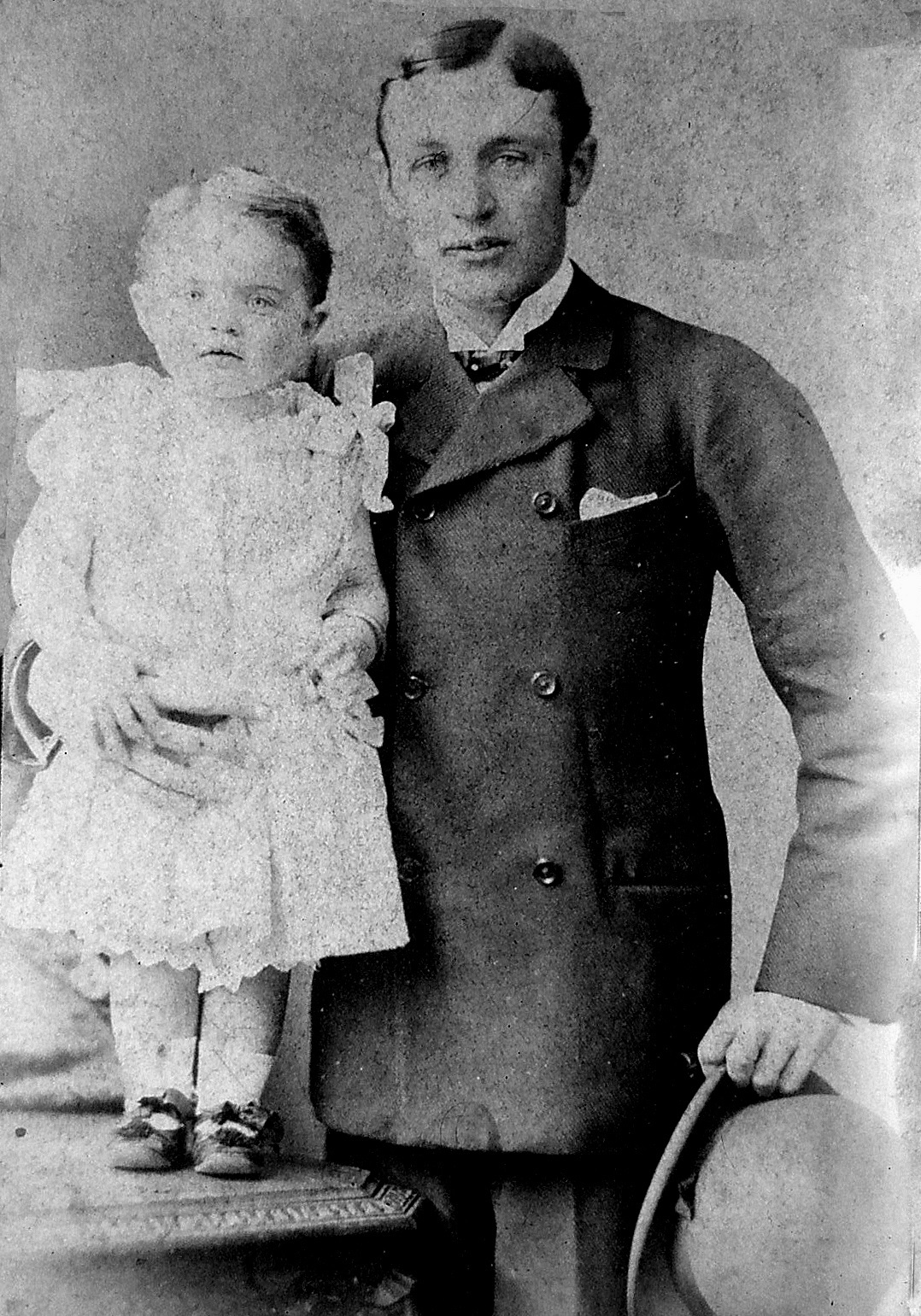
The fever got worse on Sunday and by Monday 8th November 1886 he became delirious. In the afternoon his sister, Mrs Coleman, who was caring for him, entered his bedroom only to see him put a revolver in his mouth and pull the trigger. He was buried in Newmarket cemetery on Friday 12th November, and when his will was read out, sometime later, he left £66,662 (equivalent to £7.1 million in 2019) to his only daughter Nellie, who was brought up by her grandparents in Newmarket. Falmouth House and Lodge had to begin a new chapter.
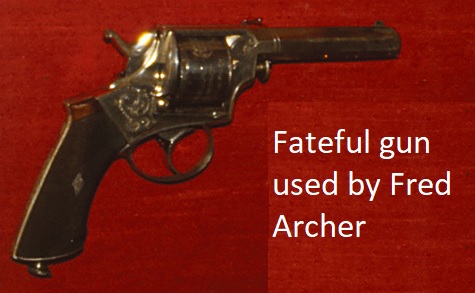
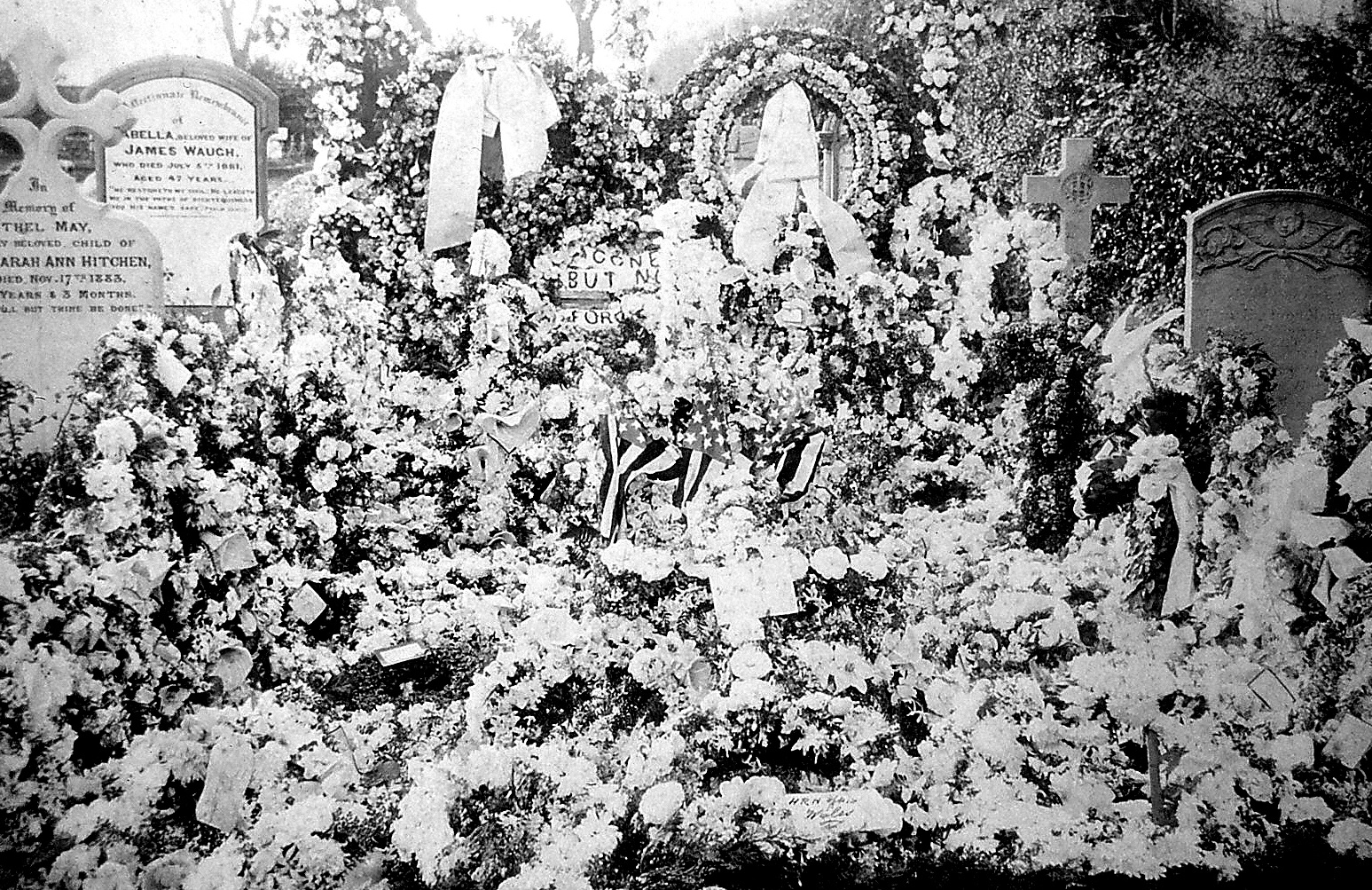
For over 4 centuries racing has been staged in Newmarket, but how have the racecourses evolved from an initial starting point at Fleam Dyke Pumping Station, some 8 miles from the town, with a winning post barely 200 metres from the town centre, into two world recognized, excellent racecourses and a universal acceptance that Newmarket is the Headquarters of racing?
To access an interactive racecourse map showing over 50 individually named racecourses CLICK HERE. The map will enable you to:-
1. Determine when extended races over 8 miles, 6 miles and 4 miles began to be replaced by the courses now visited by thousands annually;
2. Consider how the challenge of crossing the Devil's Dyke was overcome;
3. Contemplate why the town no longer has a steeplechase course despite having at least 5 courses during the past 2 centuries;
4. Examine the practicalities of having up to 48 starting posts and winning posts;
5. Appreciate that it was not financially viable to have an open racecourse spread widely across the heath, with a finishing post barely 200 metres from the town centre;
6. Research how and why the Cambridgeshire Handicap has been contested over 3 different courses.
NOTE: The map does not make mention of 2 particular courses:-
(i) Sefton Course (also known as the Cambridge Road Course)
Source: 1970 Raceform. Used from 1959 to 1975.
(ii) New Circular Course
The Circular Handicap was run on Friday 29th October 1875 on the New Circular Course of about two miles.
Source: London Standard (30th October 1875): ''the horses started near the Turn of the Lands, ran back way of the Cambridgeshire Course towards the Ditch, and afterwards proceeded down the side of the Tan Gallop, and turned into the Rowley Mile near the Bretby Stakes starting post, finishing at the stand at the end of the flat. Except in the hollow near the Cambridgeshire start the runners should have been visible all the way if the sky had been bright and clear''.
Another report hoped that the Circular Handicap would become a feature in future programmes, as it would be contested in front of the new grandstand which would be completed in about a year and would be able to accommodate thousands.
(I am grateful to Tim Cox for bringing attention to these 2 courses.)
Enjoy researching the intriguing history of Newmarket and its many racecourses.
1887 Fred Archer Auction
The Sporting Life, on Saturday 22nd January 1887, advertised items for sale from Falmouth House, the property of the late Fred Archer, including furniture, silver plates, glassware, carriages and 200 bottles of champagne.
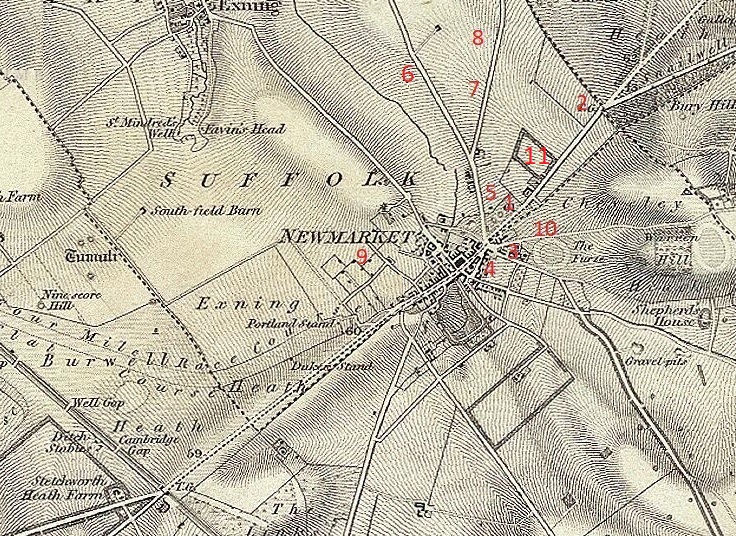
1886-1903 Sir John Blundell Maple
After Fred Archer's death Falmouth House and Lodge were put up for sale and were purchased for less than £8000 (equivalent to £1.1 million in 2019) by Sir John Blundell Maple. Sir John was born on 1st March 1845, the son of John Maple who ran a furniture shop on the Tottenham Court Road in London. After his education at King's College London, John entered the family firm and it immediately began to expand, becoming a limited company valued at £2 million in 1890. By then Sir John had entered Parliament as MP for Dulwich in 1887. As well as purchasing Falmouth House and Lodge, he also owned Childwick Bury Stud, often running his horses under the name 'Mr Childwick'. In 1891 Sir John purchased Triple Crown winner Common (SR 2019), after he had won the St Leger, from Sir Frederick Johnstone to stand at his stud.
Sir John Blundell Maple employed a number of trainers during his ownership of Falmouth House, including Percy Peck who oversaw a stable of 40 horses between 1888 and 1895, followed in quick succession by John/Joseph Day and Willie Waugh. He died on 24th November 1903, leaving £2,153,000 (equivalent to £257 million in 2019) in his will.
1889 Tradesmans Cup (now known as the Chester Cup) MILLSTREAM 13/2 owned by Sir John Blundell Maple, trained by Percy Peck and ridden by Jimmy Woodburn
1893 1000 Guineas SIFFLEUSE 100/1 (SR 1784) owned by Sir John Blundell Maple, trained by Percy Peck and ridden by Tommy Loates
1895 2000 Guineas KIRKCONNEL 10/1 (SR 1966) owned by Sir John Blundell Maple, trained by John/Joseph Day and ridden by John Watts
1898 1000 Guineas NUN NICER 11/2 (SR 1925) owned by Sir John Blundell Maple, trained by Willie Waugh and ridden by Sam Loates
1902 Sussex Stakes ROYAL LANCER owned by Sir John Blundell Maple, trained by Willie Waugh and ridden by Willie Lane

1888-1895 Sir John Blundell Maple, Percy Peck
In 1888 Sir John Maple appointed Percy Peck as his private trainer while Peck was still a teenager. Percy William Hesseltine Peck was born in 1870 into a racing family, being the eldest son of Robert Peck who won the Epsom Derby twice, firstly in 1873 with Doncaster (SR 2000), and later with Bend Or (SR 2030) in 1880. Percy began training as soon as he completed his education, and aged just 19 he won the Chester Cup, then known as the Tradesman's Cup, for Sir John Blundell Maple with Millstream. His father, Robert, had undertaken the management of Maple's horses, with the training of them handed over to son Percy. Having won the 1889 Tradesmen's Cup with Millstream, Percy achieved his greatest triumph for Sir John in the 1893 1000 Guineas with Siffleuse (SR 1784) the unfancied 100/1 winner ridden by Tommy Loates. The previous year had begun in exceptional style for Percy and Sir John, winning the Lincoln Handicap with Clarence and the Brocklesby Stakes with Minting Queen. He then won the 1894 Stewards Cup with Gangway; also landing the 1894 Cesarewitch with Childwick. He parted company with Sir John. leaving Falmouth House in 1895 after differences, unconnected with racing or finance, between his father Robert and Sir John strained their relationship, Percy moving on to become private trainer for Lord Durham at Harraton Court Stables. Later Percy received a boost when Lord Rosebery decided to send his yearlings to be trained at Harraton Court by Percy. Much later in his career Percy won the 1905 Epsom Derby with Cicero (SR 2029).
1889 Tradesman's Cup (now known as the Chester Cup) MILLSTREAM 13/2 owned by Sir John Blundell Maple, trained by Percy Peck and ridden by Tommy Loates
1892 Lincoln Handicap CLARENCE 6/1 owned by Sir John Blundell Maple, trained by Percy Peck and ridden by Fred Allsopp
1892 Brocklesby Stakes MINTING QUEEN 11/10 fav owned by Sir John Blundell Maple, trained by Percy Peck and ridden by Jimmy Woodburn
1893 1000 Guineas SIFFLEUSE 100/1 (SR 1784) owned by Sir John Blundell Maple, trained by Percy Peck and ridden by Tommy Loates
1894 Stewards Cup GANGWAY 40/1 owned by Sir John Blundell Maple, trained by Percy Peck and ridden by Walter Bradford
1894 Cesarewitch CHILDWICK 20/1 owned by Sir John Blundell Maple, trained by Percy Peck and ridden by Walter Bradford
1895-1896 Sir John Blundell Maple, John/Joseph Day
In 1895 trainer Percy Peck parted company with Sir John Maple and he was briefly replaced by Joseph Day. During his brief stay at Falmouth House, John/Joseph trained the 1895 2000 Guineas winner Kirkconnel (SR 1966) for Sir John when ridden by John Watts. By the end of the 1896 season Sir John had replaced John/Joseph Day with Willie Waugh.
1895 2000 Guineas KIRKCONNEL 10/1 (SR 1966) owned by Sir John Blundell Maple, trained by John/Joseph Day and ridden by John Watts

KIRKCONNEL (SR 1966)
The bay colt Kirkconnel, by Royal Hampton out of Sweet Sauce, was bred by Lady Stamford in 1892. As a two-year-old he won the Bedford Stakes and July Stakes before being runner-up in the Dewhurst Stakes, and placed fourth in the Middle Park Stakes. He went into the winter well fancied for Classic success, duly winning the 2000 Guineas when trained by Joseph Day and ridden by John Watts. In the Epsom Derby he was unfancied at 100/8, but managed to gain third place, beaten 3/4 length and 1/2 length by Sir Visto (SR 1966), after which his form deteriorated. In a career spanning 15 races, he won just 4 and was second on two further occasions.
1897-1903 Sir John Blundell Maple, Willie Waugh
When Sir John appointed William Waugh at the start of the 1897 season as his trainer, William hired Mr Bird as his manager, and Sam Loates and the ill-fated Willie Lane as his stable jockeys. In 1900 his brother, Dawson Waugh, returned from Hungary to act as private trainer to Prince Festetics and to be assistant to Willie whose health was struggling at this time. When Sir John died in 1903 Willie and Dawson went their separate ways, Dawson moving to train at Somerville Lodge.
1898 1000 Guineas NUN NICER 11/2 (SR 1925) owned by Sir John Blundell Maple, trained by Willie Waugh and ridden by Sam Loates
1902 Sussex Stakes ROYAL LANCER owned by Sir John Blundell Maple, trained by Willie Waugh and ridden by Willie Lane
NUN NICER (SR 1925)
The bay mare Nun Nicer, by Common out of Priestess, was owned and bred by Sir John Blundell Maple at his Childwick Stud. In her two-year-old career she managed just 3 wins from her nine races, but was quietly fancied for the 1000 Guineas. She duly obliged in the 1000 Guineas by a length at 11/2, but was soundly beaten in the Epsom Oaks by Airs and Graces (SR 1901) who won 100/8. As a four-year-old she was second in the Stewards Cup, when beaten by Northern Farmer, before winning the Preis von Donausschingen in Germany. In a career spanning 23 races, she was successful 8 times, and was placed second on 6 further occasions.


1904-1918 Harry W Sadler
Harry Sadler, great grandson of Isaac Sadler trainer of 1833 Epsom Derby winner Dangerous (SR 2015), began training in 1890 with horses belonging to Sir Leonard Brassey. In the early years of the 20th century Harry W Sadler trained in Newmarket at Falmouth House. He married Ada (nee Lane) in 1906 and their firstborn son, Harry John, was born within a year. Their second son, William Robert, was born on 28th February 1909, was educated at the Eastbourne College boarding school, and went on to become a famous Suffolk artist. He loved to paint horses, several times accompanying Sir Alfred Munnings to Newmarket Heath to do so. By far the best horse Sadler trained whilst at Falmouth House was the White Knight who won back-to-back Ascot Gold Cups in 1907 and 1908, two Coronation Cups, the Gold Vase, the Goodwood Cup and the Newbury Cup. The White Knight came extremely close to landing the Cesarewitch under the mammoth weight burden of 9st 12lbs, being narrowly beaten by Demnre to whom he was conceding 45lbs. Harry Sadler left Falmouth House before the start of the First World War, and immediately the War ended he became trainer at Heath House Stables, remaining there for the next 5 years.
1907 Coronation Cup at Epsom THE WHITE KNIGHT (7/1) owned by Tom Kirkwood and W R Wyndham, trained by Harry Sadler and ridden by William Halsey
1907 Goodwood Cup THE WHITE KNIGHT (5/4 fav) owned by Tom Kirkwood and W R Wyndham, trained by Harry Sadler and ridden by William Halsey
1908 Ascot Gold Cup THE WHITE KNIGHT (4/7 fav) owned by Tom Kirkwood and W R Wyndham, trained by Harry Sadler and ridden by William Halsey
1908 Coronation Cup at Epsom THE WHITE KNIGHT (2/1) owned by Tom Kirkwood and W R Wyndham, trained by Harry Sadler and ridden by William Halsey
1919-1920 Frank Barling
Straight after the end of the First World War Francis (Frank) William Bonner Barling trained at Falmouth Lodge for Lord Glanely,1st Baron Glanely. Frank came from Ross in Herefordshire. He reached the pinnacle of his career when he trained the unexpected winner of the 1919 Epsom Derby Grand Parade (SR 1968) at 33/1 when ridden by Fred Templeman. It proved to be a spectacular year for both owner and trainer, recording 7 wins at Royal Ascot, all of which are listed below. Frank left Falmouth House the next year due to ill health, but began training again in 1925 and 1926 at La Grange, and by 1931 had moved on to Kremlin House. During the time he operated from the various stables listed, he was also running a private stable from Primrose Cottage, passing it on to his son, Geoff Bonnor Barling, in 1934. Frank died in Newmarket on 17th April 1935.
1919 Epsom Derby GRAND PARADE 33/1 (SR 1968) owned by 1st Baron Glanely, trained by Frank Barling and ridden by Fred Templeman
1919 Prince of Wales's Stakes at Royal Ascot DOMINION 2/1 owned by Lord Glanely, trained by Frank Barling and ridden by Arthur James Smith
1919 Churchill Stakes at Royal Ascot HE (walked over) owned by Lord Glanely and trained by Frank Barling
1919 Granville Stakes at Royal Ascot LADY JULIET 11/4 owned by Lord Glanely, trained by Frank Barling and ridden by Fred Slade
1919 Visitors Handicap at Royal Ascot SKYROCKET 5/1 owned by Lord Glanely, trained by Frank Barling and ridden by Arthur James Smith
1919 St James's Palace Stakes at Royal Ascot GRAND PARADE 1/4 fav owned by Lord Glanely, trained by Frank Barling and ridden by Arthur James Smith
1919 Windsor Castle Stakes BRIGHT FOLLY 5/1 owned by Lord Glanely, trained by Frank Barling and ridden by Arthur James Smith
1919 Wokingham Stakes at Royal Ascot SCATWELL 4/1 owned by Lord Glanely, trained by Frank Barling and ridden by Fred Slade

Joseph Henry, one of 4 sons of Joseph Cannon senior, was born in Newmarket in 1877 and acted as assistant trainer to his father before going on to become assistant trainer to Honourable George Lambton at Stanley House. In 1920 he decided to train on his own account, with some newspapers claiming it was at Lordship Farm, while others claimed he trained at Falmouth House. His principal patron was Mr O Langley, although Walter Raphael also sent him a good number of horses. On 4th August 1919 he had been involved in a motorcycling accident, but this did not appear to affect his ability as a trainer. However, on 22nd November 1921 newspapers reported that Joseph Cannon junior, trainer at Falmouth House, was suffering from lung trouble and travelled to the coast to aid his recovery. On 17th February 1922 the newspapers reported that Joe Cannon was ready to return to his duties at Falmouth House after his health had improved during his prolonged stay in Bournemouth. Nevertheless, it was thought that he had never fully recovered from his accident, and he died at Dullingham on Tuesday 18th April 1822, and was cremated on Monday 24th April 1822.
April 1927-1929 Major James C Lewis, Harvey Leader junior
In April 1927 Major James Charles Lewis, formerly of Wootton House, purchased Falmouth House, along with two farms at Worlington, near Mildenhall, intending to establish a stud farm and training stable. He appointed Charles Loates to manage his stud, entering into a partnership with Mr F P Harrison to purchase a number of two-year-olds to be trained at Falmouth House by Harvey Leader junior. Their biggest success was winning the 1929 Queens Prize at Kempton Park with Glenhazel on bank holiday Monday. He maintained ownership of Falmouth House until Summer 1935.
1929 Queens Prize GLENHAZEL 9/1, owned by Mrs J C Lewis, trained by Harvey Leader junior and ridden by Harvey Leader
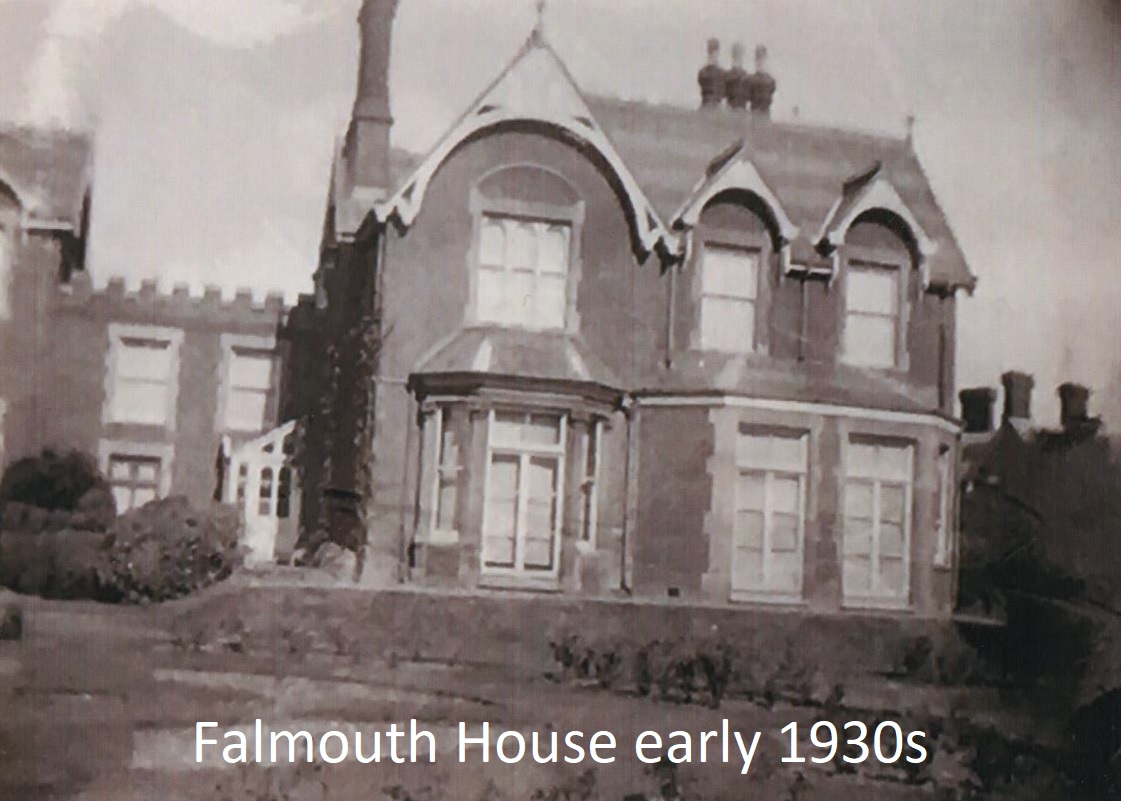
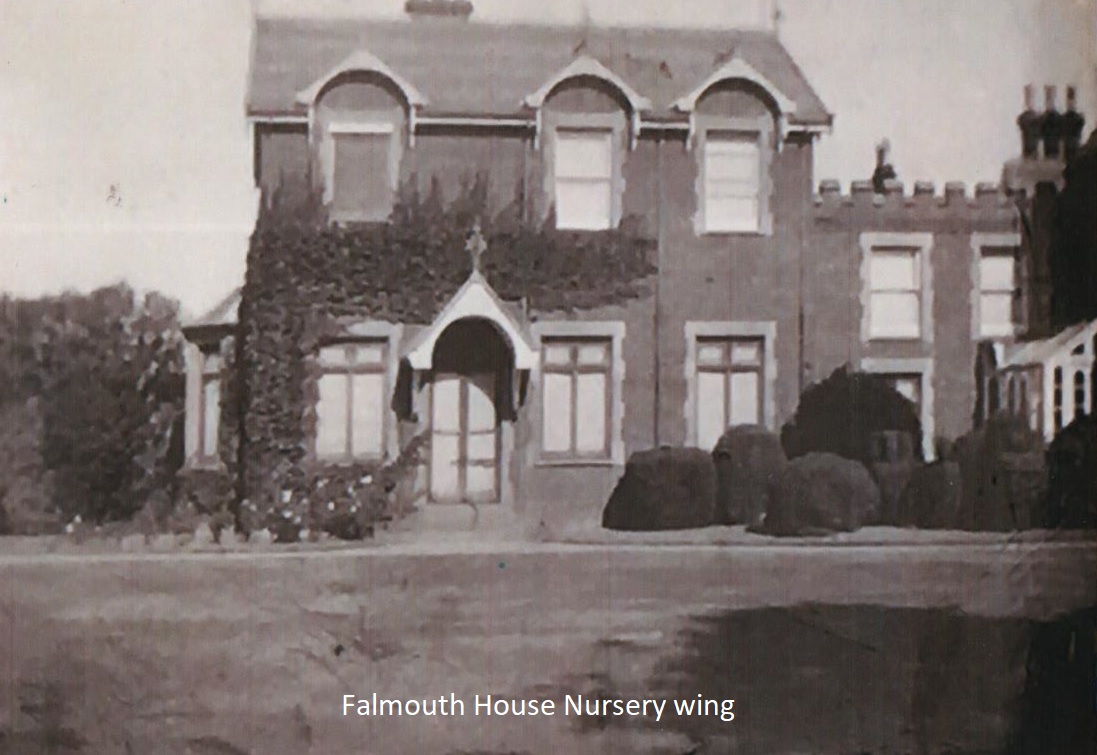
1930-1939 Gordon Sadler, Harry Sadler
When Major James Lewis left Falmouth House in 1929 Gordon Sadler, son of trainer A B Sadler, who rode for his father in the early years of the 20th century, moved to train at Falmouth House Stables. Major Lewis kept ownership until Summer 1935. Gordon had trained a number of Walter Raphael's horses earlier in his training career, before Walter moved the horses to Sam Darling. In July 1937 a new trainer, Harry J Sadler, who had been a veterinary surgeon in India, applied for a trainer's licence, intending to share Falmouth House Stables with his uncle Gordon Sadler, specifically to train for Rajah of Sarawak.
1936-1944 Major Jack Paine
For a brief period, Major Jack Paine, stud manager to Lord Derby, resided at Falmouth House, and was certainly in residence in 1936.
1945-1950 Gordon Sadler
Gordon returned to train at Falmouth Lodge for a second stint once the War had ended, although he did not win any major races. In August 1949 Gordon sold Falmouth Lodge, but continued to train there until the end of the 1950 season, as did trainers Wal Griggs junior and R Emery. Gordon retired in 1950 and was replaced by Captain Robin Oates.
I951-1962 Captain Robin Oates
Once Gordon Sadler left Falmouth Lodge the name of the training establishment changed to its present-day name of Pegasus Stables. Gordon was replaced by Captain Robin Oates who had been a Captain in the 7th Queen's Hussars during the Second World War, earning a Military Cross for his bravery in the Middle East, and then served as Assistant Trainer to Noel Murless at Beckhampton between 1947 and 1950. Robin Dorrien Grace Oates, born in Kensington, London on 9th August 1916, was the youngest of 3 sons of Bryan and Alma Oates. Robin won a number of prestigious races during his 12 year stay at Pegasus Stables, particularly with Rough in 1953, Jeanne Michelle in 1953 and Josephus in 1958 and 1959, who was unplaced in the 1959 Epsom Derby behind Parthia (SR 2047). In 1962 he left Newmarket for Oatsfield, near Battle in Sussex, while a few years later, in 1968 Falmouth House was demolished, removing an important link with Fred Archer and the past. Robin married Enid Ovenden in Devonshire and inherited his father's estate on 15th April 1964 on the death of his father, Bryan, his mother having died on 5th November 1941 at Hopleys in Horringer, Sussex. Robin died at Braintree, Essex in November 1986.
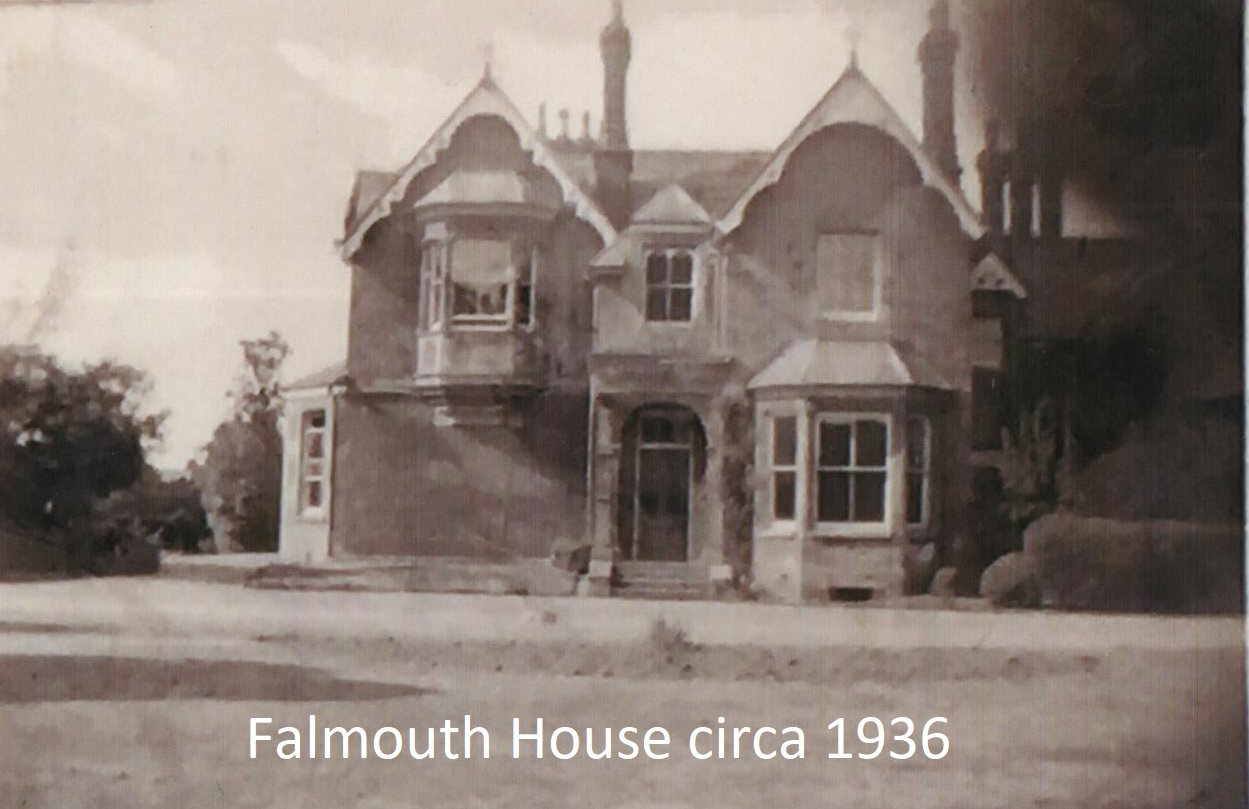
1953 Packwood Plate at Warwick ROUGH 15/8 jt fav owned and trained by Robin Oates and ridden by Scobie Breasley
1958 Lyburn Plate at Lingfield JOSEPHUS 10/11 fav owned by Mr F H Bowcher, trained by Robin Oates and ridden by Stan Clayton
1959 Great Harry Handicap at Hurst Park JOSEPHUS 9/1 owned by Mr F H Bowcher, trained by Robin Oates and ridden by Bill Rickaby
1962-1965 Maurice Moroney
Maurice Joseph Moroney was born in County Kerry on 2nd May 1897 and served his jockeys apprenticeship with J P Hogan at Limerick. He was a useful National Hunt jockey straight after the end of the First World War, riding for 20 years before turning his hand to training. In the twilight of his career he trained at Pegasus Stables for 3 years before retiring. Tragically, he was hit by a car in Newmarket on 29th November 1977 and died on 1st December from his injuries.
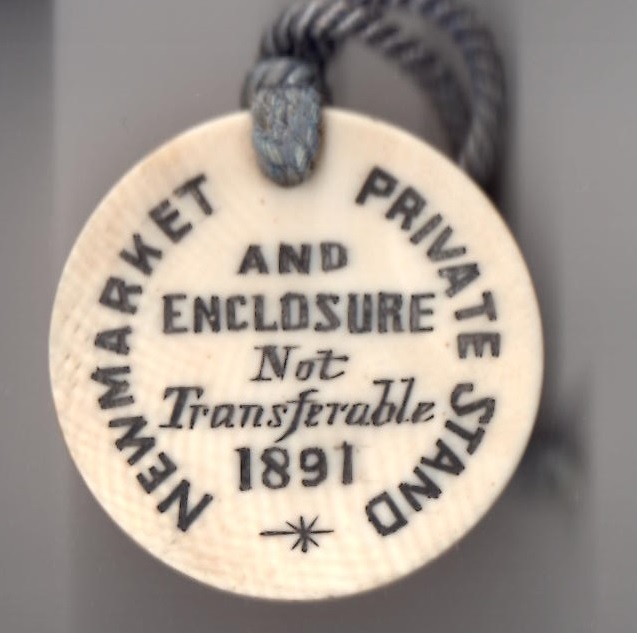
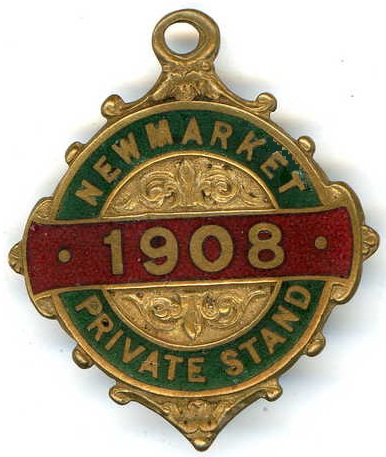
I am grateful to Peter Harris, who lived in Falmouth House with his mother and brother between 1955 and 1967, for the photos of the house taken from the late 1950s and early 1960s. The photo below left is of the South East side of Falmouth House, the part where Peter spent much of his childhood. The top left dormer window was his mother's bedroom, with the spare bedroom next door. The larger sash window was in Peter's bedroom.

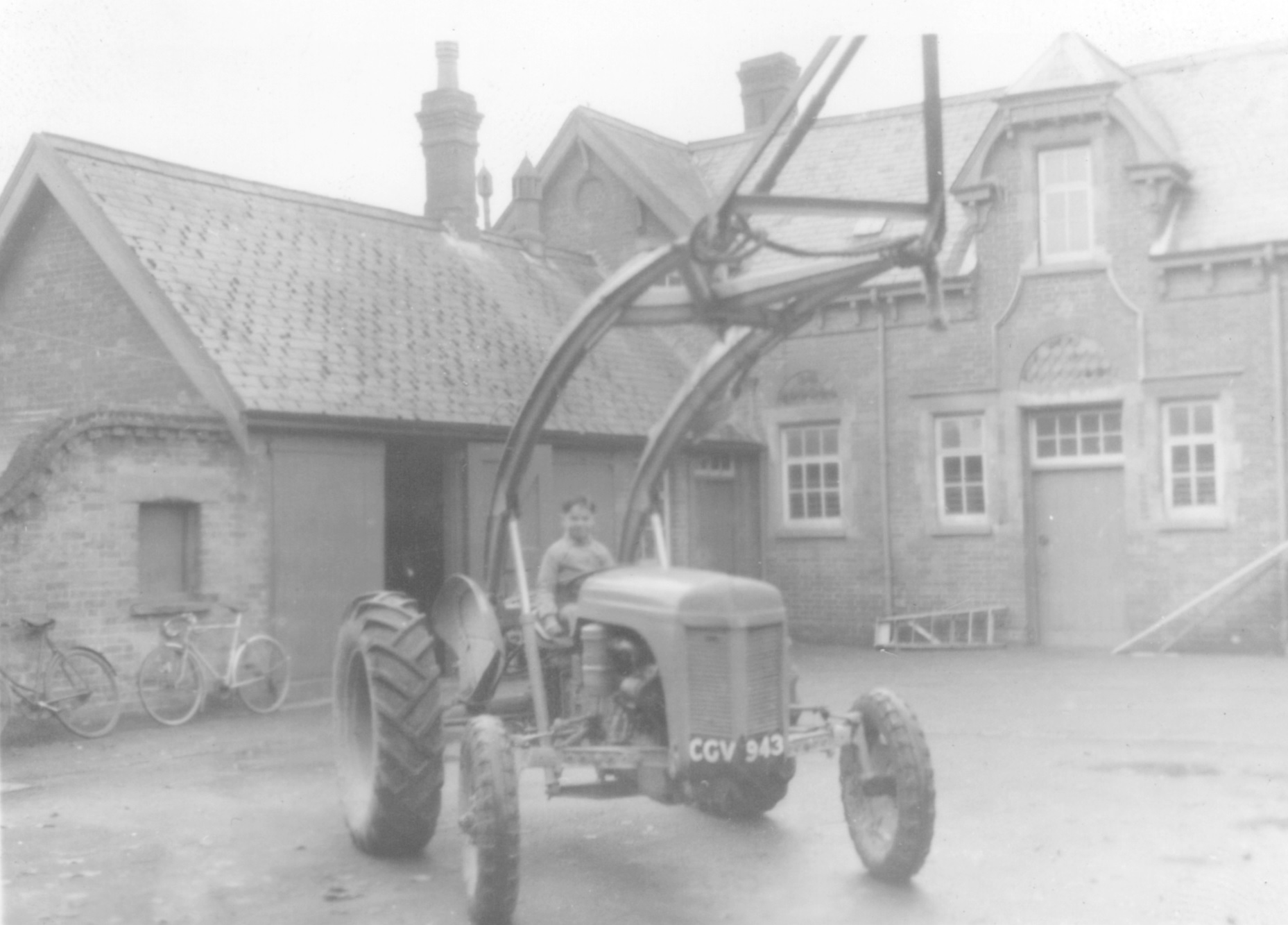
Beneath the bedrooms was the dining room and to the left of that was the kitchen, pantry and the sitting room. The original huge conservatory would have occupied most of the elevation to the right, below the blank gable. The Billiard Room wing, as it was known in Peter's time, was demolished in 1956 to allow light into the rooms centre and left which his family occupied. These were originally the servant's quarters. The small remaining conservatory is still visible, providing a link to the main house and Billiard Room wing. Although stylistically similar, it is thought this wing was added after Fred Archer's time and was part of the refurbishment his family had done by Hollands, the local builders, most of the original rather elaborate bargeboards and gable details were lost at this time. Also visible is the entrance porch and steps to the main house on the North East side.
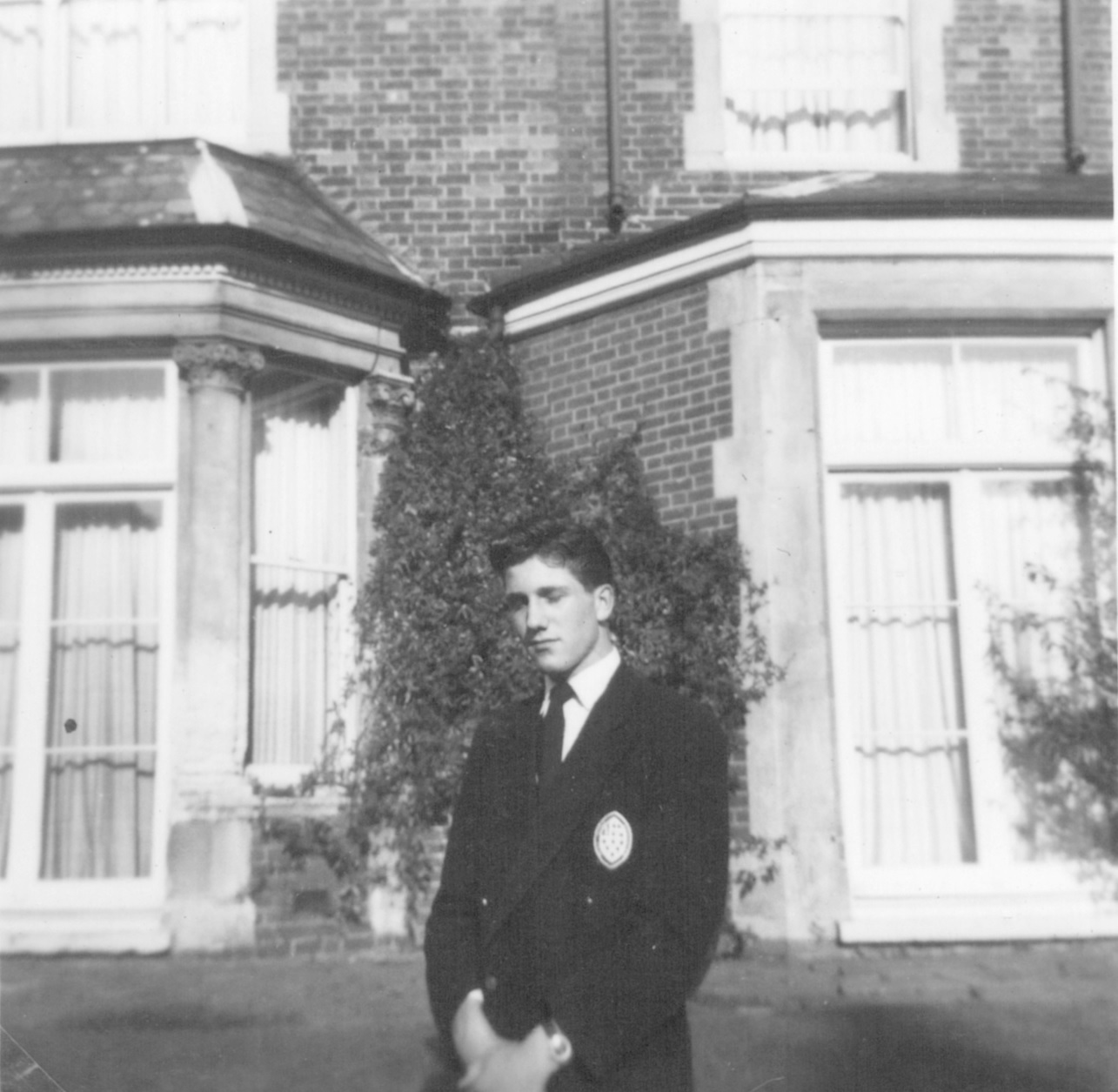
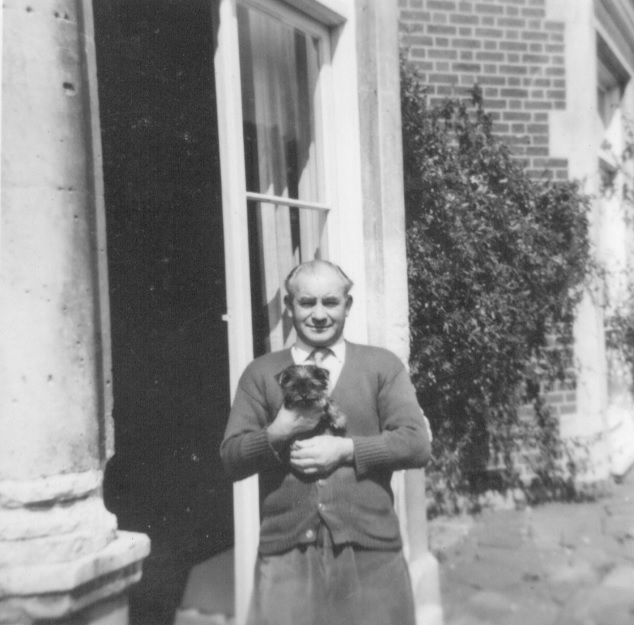
The photo, above left, shows the two sets of French windows on the garden at the South East front (The young man pictured is Martin Sluy, son of Peter’s Great Aunt). Of quite some historical interest in the racing world is a photo of ex jockey Kenneth Douglas “Ken" Robertson, who Peter referred to as Uncle Ken, and who gained a level of prominence in the 20s and 30s. Ken Robertson was married to Peter’s Aunt Helen, and they were neighbours of Peter’s grandparents when they lived in Walton upon Thames after the war. When Peter’s father was killed in Korea in 1952 Helen Robertson lifted Peter’s mother’s spirits by suggesting that they went in search of a house where the 2 families could live and support each other to give his mother the chance to recover. The families moved to Newmarket in 1955 having bought Falmouth House the year before, although at the time it was in a bit of a state. It was converted into two dwellings by the simple expedient of bricking up the doors connecting the servant’s quarters to the main house. Peter’s mother named her section Falmouth Cottage, while ‘auntie’ Helen and ‘uncle’ Ken lived in some style next door in the ‘grand’ house. Ken had retired some years beforehand due to a health problem, so the opportunity to purchase the house of the late Fred Archer must have seemed heaven-sent.

The photo opposite shows Peter's mother's Austin Mini (the first in Newmarket) which she bought in 1959/60 and was taken in the stable yard on the north west side at the rear of the house. It was a large yard bounded by a small workshop with outside toilet, a motor and coach house and stable block with living quarters above, and a substantial brick wall with gate piers leading off the front drive, and opposite a small gated passageway leading to the walled kitchen garden. Peter is shown proudly sitting on a tractor in the top right-hand photo. Most of these walls still exist in parts of the housing estate that replaced the old house. Beyond one of these walls it is possible to see the central section of the racing stable block (now Pegasus Stables) with its clock tower and spire.
1968- 1970 Bill Watts
In 1968 it felt as though the wheel had turned full circle when Bill Watts launched his training career at Pegasus Stables. His great grandfather, Charlie Archer, was brother to the great Fred Archer who had built Falmouth House and Lodge at the end of the 19th century, while his great grandmother, Alice Pratt (nee Archer) was sister to Fred Archer. Bill's immediate family was steeped in racing history; his great grandfather, John Watts, rode no less than 19 Classic winners, including landing the Epsom Derby four times; 1887 Merry Hampton (SR 2061), 1890 Sainfoin (SR 1968), 1894 Ladas (SR 2000) and 1896 Persimmon (SR 2078), while his grandfather, John E Watts, trained the 1927 Epsom Derby winner Call Boy (SR 2049). The Watts family continued to enjoy Classic success when Bill's father, Jack Watts, trained the 1964 St Leger winner Indiana (SR 2014). In his brief spell at Pegasus Stables Bill launched his training career with success in the 1968 Lingfield Oaks Trial with Our Ruby, although she finished down the field at 20/1 behind Epsom Oaks winner La Lagune (SR 1926). However, Bill won the 1970 Royal Hunt Cup at Ascot with Calpurnius 33/1, owned by Charles Engelhard and ridden by Sandy Barclay, to crown a great and memorable day for Bill, who that same morning had proposed to Pat Carver, daughter of racehorse owner Bill Carter, and she had accepted. At the end of the season Bill left Pegasus Stables, and Newmarket, bound for Hurghill Lodge Stables in Richmond, where he trained for the next 27 years before retiring.
1968 Lingfield Oaks Trial OUR RUBY 3/1 owned by Mr E A Holt, trained by Bill Watts and ridden by Jimmy LIndley
1970 Royal Hunt Cup CALPURNIUS 33/1 owned by Charles Engelhard, trained by Bill Watts and ridden by Sandy Barclay

1972-1974 Clive Brittain
After Bill Watts moved north to continue his training career there was a period of downtime at Pegagsus Stables before Clive Brittain launched his training career. Clive was born on 15th December 1934 in Wiltshire and, after completing his formal education, he began working in the racing industry. He became a stable lad for Noel Murless at Beckhampton, becoming an apprentice in 1949 aged just 15, although he struggled to make the grade. After 23 years with Sir Noel Murless, learning his trade, he took out his own licence in 1972 and moved to Pegasus Stables. Within two years he had recorded his first Royal Ascot success when Averof won the 1974 St James's Palace Stakes. He then made the move across Newmarket to Carlburg where he trained from 1974 until his retirement in 2015.
1974 St James's Palace Stakes AVEROF owned by Captain Marcos Lemos, trained by Clive Brittain and ridden by Brian Taylor
1976-1978 Michael Jarvis
In July 1975 owner David Robinson announced that he was closing his Clarehaven Stables, where his private trainer for the past 8 years was Michael Jarvis. David was reducing his horses in training, which at one time exceeded 130, and Michael Jarvis felt that it was the right time to branch out on his own. At the start of the 1976 flat season he moved to Pegasus Stables, taking with him many of the Clarehaven stable staff and David Robinson's remaining horses. In 1978 he achieved his first major success at Pegasus, winning the Ebor Handicap with Totowah. Michael remained at Pegasus Stables until 1978, then moved to Kremlin Stables, where he continued to train until his retirement on 22nd February 2011, followed all too quickly by his untimely death on 20th September 2011.
1978 Ebor Handicap TOTOWAH 20/1 owned by Lady Beaverbrook, trained by Michael Jarvis and ridden by Paul Cook


1979-1988 Patrick Haslam
Patrick Haslam was born on 10th January 1948 and took out his first trainer's licence in 1971. He began training in Lambourn, training on both the flat and National Hunt racing. Indeed, one of his two main claims to fame was that he trained a winner at every racecourse, although Ffos Las and Chelmsford City opened after he had retired. He left Lambourn in 1979 to take over at Pegasus Stables, replacing Michael Jarvis. He won the Bunbury Cup in consecutive years in 1983 and 1984 with Mummy's Pleasure, and the 1983 Richmond Stakes with Godstone. In 1984 he achieved a Royal Ascot success in the Royal Hunt Cup with Hawkley. He departed from Pegasus Stables at the end of the 1988 season, moving to Middleham in North Yorkshire. Thus, he achieved the second of his claims to fame, which is that he trained in all 3 principal training areas in the country, Lambourn, Newmarket and Middleham. He died on 14th October 2017 after a long illness.
1983 Bunbury Cup MUMMY'S PLEASURE 9/1 co fav trained by Patrick Haslam and ridden by Lester Piggott
1983 Richmond Stakes GODSTONE trained by Patrick Haslam and ridden by Graham Sexton
1984 Royal Hunt Cup HAWKLEY 10/1 trained by Patrick Haslam and ridden by Tyrone Williams
1984 Bunbury Cup MUMMY'S PLEASURE 11/2 trained by Patrick Haslam and ridden by Tyrone Williams
1989-present James Fanshawe
James Fanshawe arrived in Newmarket in 1982 as Assistant Trainer to Michael Stoute, learning his trade from him for the next 7 years. In 1988 the lease for Pegasus House was up for renewal by landlord Chris Blackwell, and James was successful in securing it. Within 3 years Chris had died, so in 1993 James was able to purchase the historic house and stables. Even during the period he had leased the stable James was able to make improvements, but those changes and improvements took on a new impetus once he owned Pegasus Stables in 1994. In 1991 he won the Eclipse Stakes for Bill Gredley with Environment Friend and, to show his versatility as a trainer, he won the 1992 Champion Hurdle, at the Cheltenham Festival, with Royal Gait for Sheikh Mohammed. He recorded a Classic success in 2000 when Arctic Owl, owned by The Owl Society syndicate, won the Irish St Leger. A second Champion Hurdle was chalked up two years later with Hors La Loi III owned by Paul Green. James continues to excel as a trainer, seldom recording a barren year without a Group success.
1991 Eclipse Stakes ENVIRONMENT FRIEND, owned by Bill Gredley, trained by James Fanshawe and ridden by George Duffield
1992 Champion Hurdle ROYAL GAIT, owned by Sheikh Mohammed, trained by James Fanshawe and ridden by Graham McCourt
1993 Champagne Stakes UNBLEST, owned by Lord Vestey, trained by James Fanshawe and ridden by George Duffield
1998 Prix du Cadran INVERMARK, owned by Sir David Wills, trained by James Fanshawe and ridden by Richard Hughes
2000 Irish St Leger ARCTIC OWL (SR 1884) owned by The Owl Society, trained by James Fanshawe and ridden by David Harrison
2002 Champion Hurdle HORS LA LOI III, owned by Paul Green, trained by James Fanshawe and ridden by Dean Gallagher
2003 Royal Hunt Cup MACADAMIA, owned by Lord Vestey, trained by James Fanshawe and ridden by Dane O'Neill
2004 July Cup FRIZZANTE, owned by Jan and Peter Hopper and Mr Grundy, trained by James Fanshawe and ridden by Johnny Murtagh
2004 Sussex Stakes SOVIET SONG, owned by Elite Racing Club, trained by James Fanshawe and ridden by Johnny Murtagh
2004 Lowther Stakes SOAR, owned by Cheveley Park Stud, trained by James Fanshawe and ridden by Johnny Murtagh
2006 Royal Hunt Cup CESARE, owned by Cheveley Park Stud, trained by James Fanshawe and ridden by Jamie Spencer
2007 Stewards Cup ZIDANE, owned by Jan and Peter Hopper, trained by James Fanshawe and ridden by Jamie Spencer
2007 Gimcrack Stakes SIR GERRY, owned by Mrs Gerry Galligan, trained by James Fanshawe and ridden by Jamie Spencer
2011 Diamond Jubilee Stakes SOCIETY ROCK, owned by Simon Gibson, trained by James Fanshawe and ridden by Pat Cosgrave
2011 Wokingham Stakes DEACON BLUES, owned by Jan and Pater Hopper and Michelle Morris, trained by James Fanshawe and ridden by Johnny Murtagh
2012 Haydock Sprint Cup SOCIETY ROCK, owned by Simon Gibson, trained by James Fanshawe and ridden by Kieren Fallon
2014 Prix de Cadran HIGH JINX, owned by Mr and Mrs W J Williams, trained by James Fanshawe and ridden by Ryan Moore
2017 Diamond Jubilee Stakes THE TIN MAN, owned by Fred Archer Racing-Ormonde, trained by James Fanshawe and ridden by Tom Queally
2018 Haydock Sprint Cup THE TIN MAN, owned by Fred Archer Racing-Ormonde, trained by James Fanshawe and ridden by Oisin Murphy
GRAND PARADE (1919 Epsom Derby, St James's Palace Stakes)
KIRCONNEL (1895 2000 Guineas)
THE WHITE KNIGHT (1907 & 1908 Ascot Gold Cup)
NUN NICER (1898 1000 Guineas)
SOVIET SONG (2004 Sussex Stakes)



